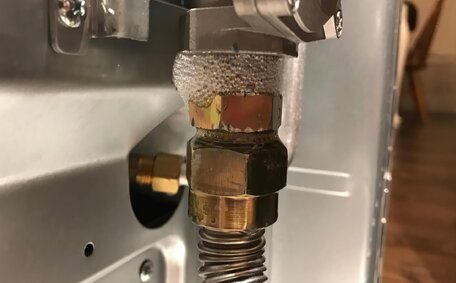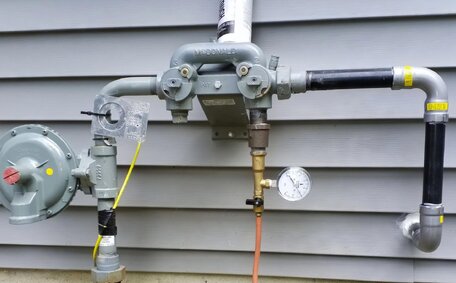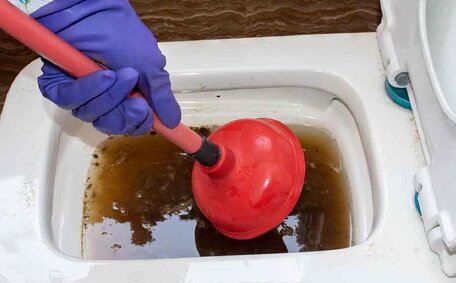Understanding Common Plumbing Emergencies
Some of the most common plumbing emergencies include:
- Blocked drains - Clogged drains can lead to sewage backups, and for plumbing health, it’s crucial to address these blockages promptly.
- Burst pipes - Ruptured pipes can rapidly flood a home and damage your property. Shut off your water supply and contact an emergency plumber immediately to prevent water damage.
- Gas leaks - Natural gas leaks put occupants at risk of explosion, fire, carbon monoxide poisoning, and more. If you smell gas, evacuate the area and call the fire department right away.
- Broken water heaters - Faulty water heaters can cause significant damage if not addressed quickly. Turn off your hot water supply and power to the water heater, ready for a plumber’s assessment and repair.
It’s important to take swift action in situations that can cause water damage in your home, securing everyone’s wellbeing.
Preparing for a Plumbing Emergency
Being prepared enables you to manage unexpected plumbing problems effectively, ensuring a prompt and safe resolution. Consider these vital steps you can take:
- Ensure you’re well-acquainted with your main water valve’s location and the steps to take during an emergency. This enables you to shut off your water supply swiftly in the event like a burst pipe occurs.
- Keep your plumber’s phone number handy. Immediate access to a professional plumber can significantly reduce damage and hasten repairs.
- Your emergency kit should contain towels, a torch, safety gloves, and a bucket to manage potential disasters effectively. Equipped with these items, you can save time, costs, and prevent accidents.
- Educate yourself on basic plumbing first aid to address minor issues before they worsen. Knowing simple fixes can often avoid further damage before the plumber arrives.
- Label pipes so you can readily identify problem areas.
- Consider installing shutoff valves under sinks and behind appliances. This enables isolation of water to specific appliances as necessary.
Taking proactive steps equips you with the ability to act swiftly, solicit help, minimise harm, and achieve peace of mind.
Assembling an Emergency Plumbing Kit
The right equipment can be crucial in responding effectively to sudden plumbing emergencies. Your DIY plumbing emergency kit should include these essential tools:
- Plunger - Tackle a blocked drain in sinks and toilets
- Bucket - Essential for collecting water from unexpected leaks
- Towels - Absorb any excess water that might cause damage to surfaces and mitigates slips
- Wrench - Instrumental to turn off water supply valve mechanisms
- Torch - Enables visibility in poorly lit areas
- Gloves - Protect your hands
- Safety goggles - Protect your eyes from flying debris and splashes
- Drain snake - Clear clogged drains
- Absorbent pads - Contain leaks
- Pipe repair tape - Temporarily seal cracks
- Tarp - Block water from spreading
Collecting these essentials enhances your ability to deal with plumbing issues.
Locating and Shutting Off Water Supply
Grasping how to shut off your primary water source is crucial, as plumbing issues can cascade rapidly. These are the steps you should follow:
- Learn to locate the main water shutoff valve well before an emergency occurs. It is usually located near the water meter or at the point where the main water line makes its entry into the home.
- Ensure the valve is truly the primary control. Confirm the main valve controls the water supply throughout your home by testing it.
- Label the valve with a highly visible tag for easy identification later.
- Use a wrench to turn the valve clockwise until tight and unable to turn further, effectively able to shut off water supply to your home’s plumbing system.
- After shutting off the main valve, turn on all taps to drain excess water and lower pressure. This action helps minimize damage if pipes burst.
- Leave taps open until emergency repairs can restore water supply.
Understanding how to quickly turn off water prepares you to assume control, seek assistance, reduce damage, and provide reassurance.
Taking Safety Precautions During a Plumbing Emergency
When faced with a plumbing emergency, safety should be your top priority. Here are some plumbing safety tips to consider:
- In the event of a gas leak, evacuate immediately, contact emergency services, and shut off the main valve if it’s safe. Do not turn any electrical devices on or off to avoid sparks.
- Use protective gear like rubber gloves, goggles, and boots to protect against electrocution, chemicals, and slipping hazards.
- Shut off the main water supply and electricity to the affected area until the issue can be repaired.
- Block off areas with water leakage using warning signs to prevent accidents.
- Open windows to ventilate the area and avoid using open flames to prevent gas buildup and potential explosions.
- Have fire extinguishers on hand in case electrical faults cause sparks or small fires.
- Seek help from knowledgeable neighbours while awaiting emergency services for prompt first aid or immediate repairs.
Heeding these safety measures during plumbing emergencies enables you to quickly tackle problems, summon professional assistance, avert harm, and prevent any undue stress.
Preventing Slips, Trips and Falls
To prevent injuries, it’s key to promptly address water leakage or spills and ensure your home’s safety. Here are tips how to best proceed:
- Cordon off or block access to wet areas using cones or furniture.
- Wear rubber-soled non-slip shoes when walking on damp surfaces.
- Put down non-slip mats, rugs or carpets over slick tile or wood.
- Post caution signage warning of wet floors in visible areas.
- Use a wet/dry vac to remove standing water - don’t allow pooling.
- Arrange temporary drainage paths using towels or boards to guide water.
- Once the leak is resolved, thoroughly dry all floors to prevent future slips.
Staying aware and quickly addressing wet areas as leaks occur lets you promptly respond, call in repair help if needed, lower risks, and give yourself peace of mind during a plumbing crisis.
Avoiding Electrical and Fire Hazards
Plumbing emergencies can create serious electrical and fire hazards if not addressed properly. Here are some key precautions:
- If appliances or outlets get wet, Turn off power at the main circuit breaker immediately if electrical hazards are present. Exercise extreme care when handling electrical equipment with wet hands, particularly during plumbing work.
- Inspect for electrical sparks or bare wires and disconnect power, especially if your water heater is implicated.
- If you smell gas, promptly leave the premises and call your emergency services. Refrain from operating any electrical devices.
- Have fire extinguishers nearby and know how to use them in case water damage causes electrical shorts or small fires.
- Prevent gas buildup - open windows and avoid open flames from lighters, matches, candles, or gas appliances.
- Place metal containers under leaks to reduce electrical conduction risks.
- Always don thick rubber gloves and boots as precautions when contending with standing water.
Staying alert and taking preventative safety measures allows you to promptly respond to plumbing emergencies, prevent any further damage, and ensure the wellbeing of those affected.
Mitigating Water Damage and Mold Risk
It’s imperative to act swiftly when faced with water damage to deter mould growth as soon possible. As soon as possible:
- Stop water flow by shutting off the main water valve or addressing leaks.
- Remove excess water with wet/dry vacuums and mops.
- Enhance airflow and drying by opening windows and using fans, akin to stopping water flow to mitigate risks.
- Quickly remove saturated porous materials like carpets to prevent mould formation.
- Use dehumidifiers to reduce moisture levels below 50%.
- Clean affected areas thoroughly with antimicrobial solutions.
- Keep a watchful eye on all your rooms over the following days and repeat drying steps if necessary.
Catching issues early allows for easier cleanup and helps avoid mould taking hold or hidden structural issues emerging later. Seek professional assistance for large-scale drying and repairs.
Calling a Professional Plumber for Help
There comes a moment during a plumbing emergency when it’s time to call a professional so you can get expert assistance. Our experienced plumbers at Kenthurst Plumbing can help assess the situation, diagnose issues, and implement solutions to get your plumbing back up and running safely, demonstrating what do during a plumbing emergency.
If you smell gas, have an uncontrollable leak, or experience electrical issues for example, call our emergency plumbing team immediately on 1300 349 338 for urgent repairs. We are available 24/7.
For other complex repairs like burst pipes, blocked sewer lines, or appliance installs, plumbers can provide the necessary expertise to rectify problems and prevent further damage. They can also provide temporary fixes to contain the issue while more comprehensive repairs are arranged.
Prioritise your safety - don’t risk perilous DIY fixes, but rather learn how handle plumbing issues with caution. Trust our team to know how handle even the most complex plumbing emergencies safely. We want to give you complete peace of mind during stressful times.
To enquire about our emergency plumbing services or book an urgent appointment call 1300 349 338 anytime. Alternatively, email us at [email protected].
Following Up After a Plumbing Emergency
After an emergency, it is crucial to comprehensively check your home to confirm all repairs are complete and effective.
File a claim with your home insurance provider for necessary repairs. It’s important to capture images of damage and keep receipts to discover more about the expenses incurred during the emergency. If temporary repairs were made, schedule a follow-up visit so a professional plumber can implement more permanent solutions.
Inspect your property carefully over the following days. Inspect areas beneath sinks and behind walls where leaks were present for any residual moisture or concealed leaks. Monitor affected areas vigilantly to ensure leaks do not reoccur or mould takes hold.
Investing in preventative maintenance for your plumbing systems is a prudent decision. Have your plumbing system inspected annually and repair identified faults proactively before they become emergencies. Installing protective measures like leak detectors, overflow valves, and shutoff switches provides added assurance.
Staying attentive during aftermath and recovery allows you to thoroughly rectify all plumbing issues, safeguard against future incidents, and give yourself lasting peace of mind.
Conducting Preventative Plumbing Maintenance
Conducting regular plumbing maintenance is essential to help prevent emergencies and costly repairs down the road. There are several simple tasks homeowners can perform themselves:
- Inspect your pipes and fittings for any signs of leaks, such as dripping water or rust. Tighten fittings or replace worn washers as needed.
- Avoid using chemical drain cleaners and opt for mild solutions like hot water and baking soda to keep pipes flowing freely.
- Inspect your hot water system for corrosion or leaks and switch it off if needed; understanding what to do maintains system functionality. Drain some water from the tank to flush sediment.
- Test sink sprayers, showerheads, and taps for adequate flow. Disassemble and clean aerators if flow is reduced.
It’s advisable to enlist professionals for annual complex maintenance, preventing potential problems before they escalate:
- A detailed camera survey of your sewer line and drain pathways to identify obstructions or pipe deterioration before overflow transpires.
- Testing water pressure and pipe integrity to pinpoint hidden leaks.
- Flushing water heaters and safety inspections of gas lines.
- Evaluating appliances such as dishwashers and insink garbage disposal units for possible malfunctions.
Allocating resources for consistent plumbing upkeep can prevent unexpected costs and distress from emergency situations and property damage.






